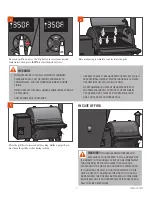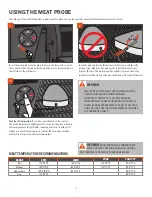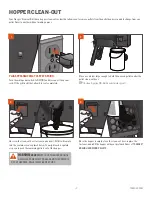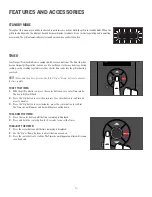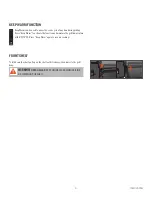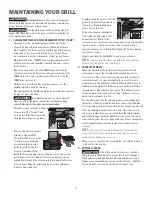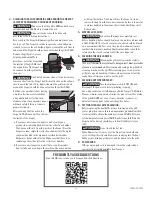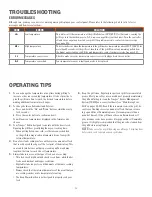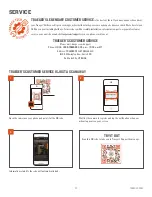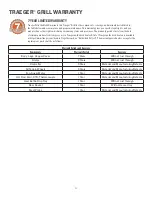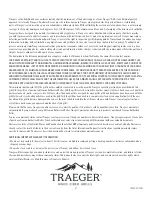
22
MAINTAINING YOUR GRILL
w
WARNING
Fire Hazard:
Grease fires are most frequently
caused by failing to properly maintain the grill by not cleaning the
grease from the grill on a consistent basis.
w
WARNING
Turn the main power switch on back of the grill
hopper OFF (
O
) and disconnect the power cord before initiating any
of the maintenance below.
1.
CLEANING YOUR TRAEGER® GREASE MANAGEMENT SYSTEM (“TGMS”):
During your cooks, grease drippings will fall onto (i) the
grease drip tray and be channeled into (ii) the grease drain
(the “Trough”) and then out of the grill through (iii) the grease
drain tube, (iv) to be collected in the grease bucket. These
four components are the components of the Traeger® Grease
Management System (TGMS). Grease will accumulate in all
of these locations and should be regularly cleaned to reduce
the risk of fire.
How often you need to clean the TGMS depends on the fat
content of your food. Fattier foods will require cleaning of the
TGMS more often, and sometimes you will need to clean the
TGMS after every cook.
Visible pieces of food and bits of hardened grease or other
buildup indicate a need for cleaning.
All components of the TGMS should be inspected before each use
for signs of grease buildup.
w
WARNING
Accumulated grease is easier to clean off
when the grill is still warm—not hot.
Be careful not to burn
yourself. Heat-protective gloves are recommended.
Clean the grease out of the V-shaped
grease drain (the “Trough”) and
grease drain tube. We recommend
cleaning these locations regularly.
Remove all grill grates, grease
drip tray, and heat baffle.
This will provide access to the
V-shaped grease drain and
grease drain tube opening
inside the grill. Scrape the
grease accumulation from
inside the V-shaped grease drain and grease drain tube using
a stiff, nonmetallic tool. Much of the loosened grease can be
pushed down through the grease drain tube and will fall into the
grease bucket. Wipe up remaining grease residue with paper
towels or disposable rags.
Regularly clean the grease out of the
grill on the interior bottom and sides.
If grease is allowed to build up, a
grease fire could result.
Scrape the grease accumulation
from inside the grill using a stiff,
nonmetallic tool. Much of the
loosened grease can be removed using paper towels or disposable
rags. Excessive scraped-off residue can be cleaned using a
vacuum cleaner as described in Step 4 (page 23) when cleaning
the firepot of ashes.
Inspect and clean the heat baffle for any grease or debris.
NOTE:
Traeger’s drip tray liners can help keep your grill clean
and can help reduce the risk of flare-ups.
2.
CREOSOTE REMOVAL:
When wood pellets are burned slowly, they produce tar and
other organic vapors that combine with expelled moisture to
form creosote. The creosote vapors condense in the relatively
cool exhaust vent of a slow-burning fire. As a result, creosote
accumulates on the exhaust vent lining. When ignited, creosote
makes an extremely hot fire. Airborne grease particles will travel
through the cooking chamber, and some of this airborne grease
will accumulate on the exhaust vent lining, similar to creosote,
which could contribute to a fire.
Periodically scrape the creosote and grease accumulation from
the inside of the vertical and horizontal sections of the flue pipe
or interior lining using a stiff, nonmetallic tool. A wooden paint stir
stick, for example, would work for this task. Once the creosote
and grease residue have been loosened from the interior lining
and ventilation gaps in this downdraft system, much of it can be
removed with paper towels or disposable rags. Do not spray water
or other liquid cleaners onto the inside of your grill to remove
creosote.
NOTE:
The Traeger® Downdraft Exhaust System should be
inspected at least twice a year to determine when a creosote
and/or grease buildup has occurred.
When creosote or grease has accumulated, it should be removed
to reduce the risk of a fire.
3.
OUTSIDE STORAGE:
w
CAUTION
If the grill is stored outside, care should be
taken to ensure that water does not get into the pellet hopper.
Wood pellets expand greatly when wet and will jam your auger.
Always cover your grill when not in use with a Traeger® Grill Cover.
This custom-fit cover can be purchased at traeger.com.










